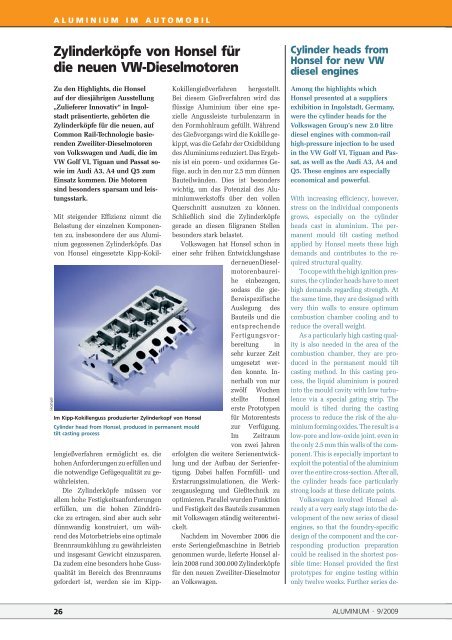special - Alu-web.de
special - Alu-web.de
special - Alu-web.de
Create successful ePaper yourself
Turn your PDF publications into a flip-book with our unique Google optimized e-Paper software.
Honsel<br />
A L U M I N I U M I M A U t o M o b I L<br />
Zylin<strong>de</strong>rköpfe von Honsel für<br />
die neuen vW-Dieselmotoren<br />
Zu <strong>de</strong>n Highlights, die Honsel<br />
auf <strong>de</strong>r diesjährigen Ausstellung<br />
„Zulieferer Innovativ“ in Ingolstadt<br />
präsentierte, gehörten die<br />
Zylin<strong>de</strong>rköpfe für die neuen, auf<br />
Common Rail-Technologie basieren<strong>de</strong>n<br />
Zweiliter-Dieselmotoren<br />
von Volkswagen und Audi, die im<br />
VW Golf VI, Tiguan und Passat sowie<br />
im Audi A3, A4 und Q5 zum<br />
Einsatz kommen. Die Motoren<br />
sind beson<strong>de</strong>rs sparsam und leistungsstark.<br />
Mit steigen<strong>de</strong>r Effizienz nimmt die<br />
Belastung <strong>de</strong>r einzelnen Komponenten<br />
zu, insbeson<strong>de</strong>re <strong>de</strong>r aus <strong>Alu</strong>minium<br />
gegossenen Zylin<strong>de</strong>rköpfe. Das<br />
von Honsel eingesetzte Kipp-Kokil-<br />
Im Kipp-Kokillenguss produzierter Zylin<strong>de</strong>rkopf von Honsel<br />
Cylin<strong>de</strong>r head from Honsel, produced in permanent mould<br />
tilt casting process<br />
lengießverfahren ermöglicht es, die<br />
hohen Anfor<strong>de</strong>rungen zu erfüllen und<br />
die notwendige Gefügequalität zu gewährleisten.<br />
Die Zylin<strong>de</strong>rköpfe müssen vor<br />
allem hohe Festigkeitsanfor<strong>de</strong>rungen<br />
erfüllen, um die hohen Zünddrücke<br />
zu ertragen, sind aber auch sehr<br />
dünnwandig konstruiert, um während<br />
<strong>de</strong>s Motorbetriebs eine optimale<br />
Brennraumkühlung zu gewährleisten<br />
und insgesamt Gewicht einzusparen.<br />
Da zu<strong>de</strong>m eine beson<strong>de</strong>rs hohe Gussqualität<br />
im Bereich <strong>de</strong>s Brennraums<br />
gefor<strong>de</strong>rt ist, wer<strong>de</strong>n sie im Kipp-<br />
Kokillengießverfahren hergestellt.<br />
Bei diesem Gießverfahren wird das<br />
flüssige <strong>Alu</strong>minium über eine spezielle<br />
Angussleiste turbulenzarm in<br />
<strong>de</strong>n Formhohlraum gefüllt. Während<br />
<strong>de</strong>s Gießvorgangs wird die Kokille gekippt,<br />
was die Gefahr <strong>de</strong>r Oxidbildung<br />
<strong>de</strong>s <strong>Alu</strong>miniums reduziert. Das Ergebnis<br />
ist ein poren- und oxidarmes Gefüge,<br />
auch in <strong>de</strong>n nur 2,5 mm dünnen<br />
Bauteilwän<strong>de</strong>n. Dies ist beson<strong>de</strong>rs<br />
wichtig, um das Potenzial <strong>de</strong>s <strong>Alu</strong>miniumwerkstoffs<br />
über <strong>de</strong>n vollen<br />
Querschnitt ausnutzen zu können.<br />
Schließlich sind die Zylin<strong>de</strong>rköpfe<br />
gera<strong>de</strong> an diesen filigranen Stellen<br />
beson<strong>de</strong>rs stark belastet.<br />
Volkswagen hat Honsel schon in<br />
einer sehr frühen Entwicklungshase<br />
<strong>de</strong>r neuen Dieselmotorenbaureihe<br />
einbezogen,<br />
sodass die gießereispezifische<br />
Auslegung <strong>de</strong>s<br />
Bauteils und die<br />
entsprechen<strong>de</strong><br />
Fertigungsvorbereitung<br />
in<br />
sehr kurzer Zeit<br />
umgesetzt wer<strong>de</strong>n<br />
konnte. Innerhalb<br />
von nur<br />
zwölf Wochen<br />
stellte Honsel<br />
erste Prototypen<br />
für Motorentests<br />
zur Verfügung.<br />
Im Zeitraum<br />
von zwei Jahren<br />
erfolgten die weitere Serienentwicklung<br />
und <strong>de</strong>r Aufbau <strong>de</strong>r Serienfertigung.<br />
Dabei halfen Formfüll- und<br />
Erstarrungssimulationen, die Werkzeugauslegung<br />
und Gießtechnik zu<br />
optimieren. Parallel wur<strong>de</strong>n Funktion<br />
und Festigkeit <strong>de</strong>s Bauteils zusammen<br />
mit Volkswagen ständig weiterentwickelt.<br />
Nach<strong>de</strong>m im November 2006 die<br />
erste Seriengießmaschine in Betrieb<br />
genommen wur<strong>de</strong>, lieferte Honsel allein<br />
2008 rund 300.000 Zylin<strong>de</strong>rköpfe<br />
für <strong>de</strong>n neuen Zweiliter-Dieselmotor<br />
an Volkswagen.<br />
Cylin<strong>de</strong>r heads from<br />
Honsel for new vW<br />
diesel engines<br />
Among the highlights which<br />
Honsel presented at a suppliers<br />
exhibition in Ingolstadt, Germany,<br />
were the cylin<strong>de</strong>r heads for the<br />
Volkswagen Group’s new 2.0 litre<br />
diesel engines with common-rail<br />
high-pressure injection to be used<br />
in the VW Golf VI, Tiguan and Passat,<br />
as well as the Audi A3, A4 and<br />
Q5. These engines are e<strong>special</strong>ly<br />
economical and powerful.<br />
With increasing efficiency, however,<br />
stress on the individual components<br />
grows, e<strong>special</strong>ly on the cylin<strong>de</strong>r<br />
heads cast in aluminium. The permanent<br />
mould tilt casting method<br />
applied by Honsel meets these high<br />
<strong>de</strong>mands and contributes to the required<br />
structural quality.<br />
To cope with the high ignition pressures,<br />
the cylin<strong>de</strong>r heads have to meet<br />
high <strong>de</strong>mands regarding strength. At<br />
the same time, they are <strong>de</strong>signed with<br />
very thin walls to ensure optimum<br />
combustion chamber cooling and to<br />
reduce the overall weight.<br />
As a particularly high casting quality<br />
is also nee<strong>de</strong>d in the area of the<br />
combustion chamber, they are produced<br />
in the permanent mould tilt<br />
casting method. In this casting process,<br />
the liquid aluminium is poured<br />
into the mould cavity with low turbulence<br />
via a <strong>special</strong> gating strip. The<br />
mould is tilted during the casting<br />
process to reduce the risk of the aluminium<br />
forming oxi<strong>de</strong>s. The result is a<br />
low-pore and low-oxi<strong>de</strong> joint, even in<br />
the only 2.5 mm thin walls of the component.<br />
This is e<strong>special</strong>ly important to<br />
exploit the potential of the aluminium<br />
over the entire cross-section. After all,<br />
the cylin<strong>de</strong>r heads face particularly<br />
strong loads at these <strong>de</strong>licate points.<br />
Volkswagen involved Honsel already<br />
at a very early stage into the <strong>de</strong>velopment<br />
of the new series of diesel<br />
engines, so that the foundry-specific<br />
<strong>de</strong>sign of the component and the corresponding<br />
production preparation<br />
could be realised in the shortest possible<br />
time: Honsel provi<strong>de</strong>d the first<br />
prototypes for engine testing within<br />
only twelve weeks. Further series <strong>de</strong>-<br />
26 ALUMINIUM · 9/2009
















